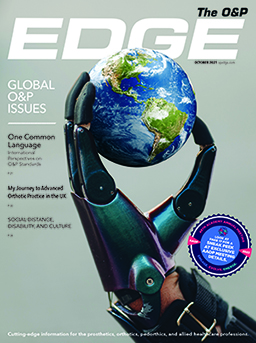P-Cell: What Does Independent Testing Show
 |
| P-Cell |
Most diabetic foot problems can be managed with some combination of foot orthosis (insole) and properly fitting shoes. Insoles are important for diabetics because they protect the skin and foot and act as a supplement to the fat pad on the bottom of the foot. Cushioning insoles are prescribed to protect and cushion the sole and distribute weight-bearing force, which reduces the pressure concentration on plantar skin and under bony prominences. An insole should provide shock absorption and reduce shear stress.
Although LD45 Pink Plastazote® is the current industry standard soft tissue supplement used in shoe insoles for diabetics, it has limitations. A concern noted by practitioners in the diabetic footwear industry is that Plastazote displays a rapid and extreme loss of thickness, which is known as "bottoming out." Another study stated that Plastazote should not be used as a shock-absorbing material. These concerns about Plastazote led to the development of a new product, P-Cell", which may be used as an alternative to Plastazote.
 |
| QUIKfit Lite |
A study was commissioned by P-Cell manufacturer, Acor, to compare P-Cell to Plastazote. The testing was performed at two independent testing facilities, SATRA and Artech. For a more detailed report on the tests, please refer to Plastazote: Pratitioners' Choise for Diabetic Orthotics.
After reviewing the test results, we conclude that P-Cell performed more favorably than Plastazote in the areas of shock absorption, cushioning, durability, abrasion, friction, tensile strength, and moisture deflection. These tests have also shown that P-Cell is non-cytotoxic, is not considered to be a primary skin irritant, and is not a skin sensitizing agent.
All of these areas represent important insole features for all types of feet, especially diabetic feet.
Shock absorption and cushioning: Because the diabetic foot can be insensate, it is prone to injury and irritation. The ability of footwear to disperse and absorb shock every time the foot/footwear hits the ground is essential.
P-Cell's superior cushioning and shock absorption properties are desirable to protect the diabetic foot from potential injury.
Abrasion: A less abrasive insole can help protect the diabetic foot. The more abrasive the surface of the insole, the more likely the foot will become irritated, which may result in blistering or ulcerations. P-Cell is less abrasive than Plastazote.
 |
| Comfort Stride |
Coefficient of friction: A secure grip inside a shoe prevents shear on the foot from slipping inside the shoe. Excessive movement in the shoe can allow the foot to rub against the upper, resulting in soreness. P-Cell has a higher coefficient of friction than Plastazote.
Moisture deflection: Insoles that absorb body fluids are harder to keep clean and allow for bacterial growth near the foot. Bacteria on a diabetic foot could allow complications, such as infections, to develop. P-Cell displayed higher moisture deflection than Plastazote.
Durability and tensile strength: P-Cell's higher durability and tensile strength allow for longer wearability and life of insoles than Plastazote.
Since its introduction to the market, O&P practitioners have also used P-Cell in the lining of AFOs, body jackets, prosthetic sockets, and CROW walkers. P-Cell is grindable and heat moldable at 250°-275° F.
Director of clinical education for Acor.
Clinical educator for Accor.
References
National Institute of Diabetes and Digestive and Kidney Diseases. National Diabetes Statistics fact sheet: general information and national estimates on diabetes in the United States, 2000. Bethesda, MD: U.S. Department of Health and Human Services, Nat
Sammarco GJ. The foot in diabetes. Philadelphia: Lea & Febiger, 1991.
Brodsky JW, Kourosh S, Stills M, Mooney V. Objective evaluation of insert material for diabetic and athletic material. Foot Ankle 1988;9(3):111-116.
Dahmen R, Haspels R, Koomen B, Hoeksma AF. Therapeutic footwear for the neuropathic foot. Diabetes Care 2001;24(4):705-709.
Pratt DJ, Rees PH, Rodgers C. Assessment of some shock absorbing insoles. Prosthet Orthot Int 1986;10(1):43-45.
SGS US Testing Company, Inc. Test Report No: 171444. Oct. 31, 2002. USP 25 Biological Reactivity Test In-Vitro (87), MEM Elution.
SGS US Testing Company, Inc. Test Report No: 171444.001. Nov. 7, 2002. Primary Dermal Irritation per ISO Standards.
SATRA Report Reference: 28190/0210/MPE-P. April 22, 2002.
ARTECH Report No.: F20065. March 13, 2002.
SGS U.S. Testing Company, Inc. Test Report No. 172382, January 6, 2003. Skin Sensitization Test, Guinea Pigs Maximization Test.






-
-
-
-
CONTACT US